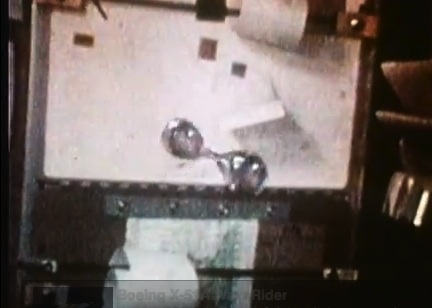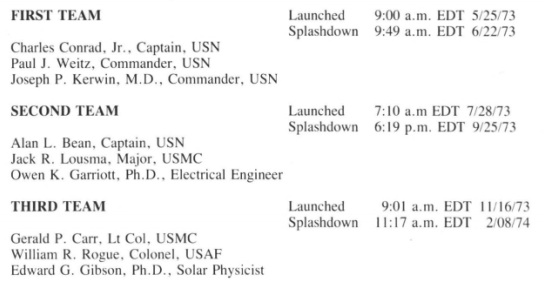Difference between revisions of "User:Tohline/ThreeDimensionalConfigurations/BinaryFission"
(→Drop Dynamics Experiments: Elaborate on zero-g drop dynamics experiments) |
(Add more information on shuttle flight experiments) |
||
| Line 5: | Line 5: | ||
==Qualitative Illustration== | ==Qualitative Illustration== | ||
<div align="center"> | <div align="center"> | ||
| Line 13: | Line 10: | ||
<tr> | <tr> | ||
<td align="center"> | <td align="center"> | ||
'''Figure 1''' | |||
<br> | |||
[[File:SkylabFission.jpg|400px|Droplet Fission]] | [[File:SkylabFission.jpg|400px|Droplet Fission]] | ||
<br><br> | <br><br> | ||
| Line 22: | Line 21: | ||
<tr> | <tr> | ||
<td align="center"> | <td align="center"> | ||
'''Figure 2''' | |||
<br> | |||
[[File:HachisuEriguchi1984.jpg|400px|Hachisu & Eriguchi scenario]]<br> | [[File:HachisuEriguchi1984.jpg|400px|Hachisu & Eriguchi scenario]]<br> | ||
[http://adsabs.harvard.edu/abs/1984Ap%26SS..99...71H Hachisu & Eriguchi (1984)] | [http://adsabs.harvard.edu/abs/1984Ap%26SS..99...71H Hachisu & Eriguchi (1984)] | ||
| Line 60: | Line 61: | ||
</div> | </div> | ||
* '''<font color="darkblue">Space Shuttle Flights</font>''' (circa 1992): | * '''<font color="darkblue">Space Shuttle Flights</font>''' (circa 1992): Experiments illustrating the ''fission'' of liquid drops were evidently also conducted during a couple of space shuttle missions. The experiments were performed with the aid of a "Drop Physics Module (DPM)" inside the "portable" United States Microgravity Laboratory (USML) that was housed in the shuttle's payload bay. | ||
** The first mission — [http://www.nasa.gov/mission_pages/shuttle/shuttlemissions/archives/sts-50.html USML-1 during shuttle flight STS-50] — took place in early 1992. According to [http://www.jpl.nasa.gov/releases/95/release_1995_9571.html information provided by NASA/JPL's public information office], "… the transition of rotating liquid drops into a 'dog-bone,' or two-lobed shape, was studied in detail …" Detailed results from DPM experiments during the USML-1 mission have been published in the Journal of Fluid Mechanics: T. G. Wang, A. V. Anilkumar, C. P. Lee and K. C. Lin (1994). ''Bifurcation of rotating liquid drops: results from USML-1 experiments in Space.'' [http://dx.doi.org/10.1017/S0022112094002612 Journal of Fluid Mechanics, 276, pp 389-403] | |||
** The second mission — [http://www.nasa.gov/mission_pages/shuttle/shuttlemissions/archives/sts-73.html USML-2 during shuttle flight STS-73] — took place in the fall of 1995. | |||
* '''<font color="darkblue">International Space Station</font>''' (circa 2000): | * '''<font color="darkblue">International Space Station</font>''' (circa 2000): | ||
Revision as of 01:58, 2 January 2014
Fission Hypothesis of Binary Star Formation

|
|---|
| | Tiled Menu | Tables of Content | Banner Video | Tohline Home Page | |
Qualitative Illustration
|
Figure 1
|
|
Figure 2
|
Related Discussions
Drop Dynamics Experiments
[On 1 January 2014, J. E. Tohline wrote ...] As I was putting this chapter together, I had difficulty documenting the various drop dynamics experiments that have been conducted by astronauts in various Earth-orbiting (zero <math>g</math>) environments. Here is the relevant information that I have found, to date:
- Skylab (circa 1973-1974): Experiments showing the fission of liquid drops were evidently conducted during the Skylab 2, Skylab 3, and Skylab 4 missions.
- As has been documented in a short film review written by Howard Voss and published in the American Journal of Physics (44/10, 1021, Oct 1976), film footage from a variety of Skylab experiments was produced by NASA, edited by Thomas Campbell & Robert Fuller, and, beginning in 1976, distributed as 12 Super 8 film loops by the American Association of Physics Teachers (AAPT).
- As is documented in A Teacher's Guide for the Skylab Physics Videodisc the content of all 12 Super 8 film loops was made available for distribution in Videodisc format in 1987 through the AAPT.
- The YouTube video referenced in and linked to the caption of Figure 1, above, is the digitized version of the Skylab film loop that illustrates fission of a water droplet.
|
According to the Teacher's Guide mentioned above, the activities shown in the above-referenced films were carried out by three teams of Skylab Astronauts: |
|
|
|
|
- Space Shuttle Flights (circa 1992): Experiments illustrating the fission of liquid drops were evidently also conducted during a couple of space shuttle missions. The experiments were performed with the aid of a "Drop Physics Module (DPM)" inside the "portable" United States Microgravity Laboratory (USML) that was housed in the shuttle's payload bay.
- The first mission — USML-1 during shuttle flight STS-50 — took place in early 1992. According to information provided by NASA/JPL's public information office, "… the transition of rotating liquid drops into a 'dog-bone,' or two-lobed shape, was studied in detail …" Detailed results from DPM experiments during the USML-1 mission have been published in the Journal of Fluid Mechanics: T. G. Wang, A. V. Anilkumar, C. P. Lee and K. C. Lin (1994). Bifurcation of rotating liquid drops: results from USML-1 experiments in Space. Journal of Fluid Mechanics, 276, pp 389-403
- The second mission — USML-2 during shuttle flight STS-73 — took place in the fall of 1995.
- International Space Station (circa 2000):
Online References
- The Fission Mechanism for Binary Star Formation
- Fission Simulations at LSU
- T. G. Wang, A. V. Anilkumar, C. P. Lee and K. C. Lin (1994). Bifurcation of rotating liquid drops: results from USML-1 experiments in Space. Journal of Fluid Mechanics, 276, pp 389-403

|
|---|
|
© 2014 - 2021 by Joel E. Tohline |



